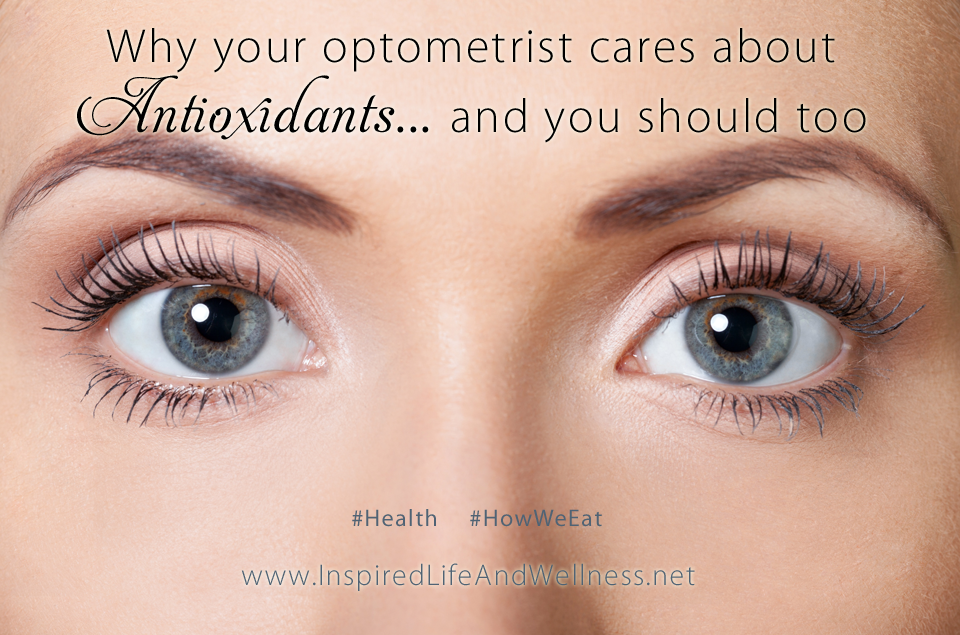 Antioxidants. We’ve all heard of them. They’re substances found in certain foods that protect our body from damage caused by free radicals, which are unstable molecules that destroy cells and play a role in many diseases. Can you say anti-aging?
Antioxidants. We’ve all heard of them. They’re substances found in certain foods that protect our body from damage caused by free radicals, which are unstable molecules that destroy cells and play a role in many diseases. Can you say anti-aging?
What do these antioxidants have to do with your optometrist? Well, last week I went to the optometrist for my annual exam. I sat down for my usual Optomap retinal scan that takes a picture of the back of my eye. Why is this necessary? Because I have a mole near the retina of my eye. Weird, right? Who knew?
The retinal scan lets the doctor keep an eye out for changes in that mole just like we look for changes in moles anywhere else on our bodies. The scan can also give indicators of other health issues we may need to explore.
Back to the antioxidants… At this visit, I was given a new test I’d never had before. It was called an M-POD (stands for macular pigment optical density). The test measures pigment levels in the macula at the back of the eye. Low pigment levels indicate a risk of macular degeneration. According to the American Macular Degeneration Foundation, it is the leading cause of vision loss, affecting more than 10 million Americans. That’s more than cataracts and glaucoma combined.
2 Important Antioxidants: Lutein and Zeaxanthin
The two pigments measured by the test are Lutein and Zeaxanthin. These yellow to red pigments, known as antioxidants, are believed to protect the macula and reduce the risk of oxidative damage that could lead to macular degeneration. It’s also believed that lutein may help protect against the buildup of fatty deposits in arteries, which is what leads to most heart attacks.
The first piece of good news? My levels of the Lutein and Zeaxanthin antioxidants were off the charts! In fact, the optometrist said she’d never seen anyone with a score that high (thank you very much). My whole foods lifestyle has paid off yet again.
How to Increase Your Lutein and Zeaxanthin Levels
The second piece of good news? You can increase your levels of Lutein and Zeaxanthin too! Both are found in dark, leafy green vegetables like kale, broccoli, Swiss chard, collards and bok choy, as well as other yellow, orange or red plant-based foods like mangoes, corn, sweet potatoes, peppers, carrots, squash, and tomatoes.
Yes, you could take a supplement to increase your intake of these antioxidants. But the best source of nutrients always comes from fresh, whole foods.
When I was first starting out, I found a daily green smoothie the best way to increase my intake of plant-based foods. Most lunches now include a large salad. And dinner? Once I discovered the seasonings and healthy oils (like olive oil and coconut oil) I could use to prepare fresh vegetables, their flavor began to entice me as well.
Over time, I began to discover and appreciate their natural flavors without a need for cooking and seasoning. I promise, you will too.
What leafy green, red, orange, or yellow vegetable or fruit will you try this week to start increasing YOUR Lutein and Zeaxanthin levels? Share in the comments below or on the Inspired Life and Wellness Facebook page! Your eyes and arteries will thank you.
Sources:
American Macular Degeneration Foundation
What is Macular Degeneration?
Dr. Andrew Weil
Lutein: Good for Your Eyes and Heart
Web M.D.
Lutein and Zeaxanthin for Vision

 Julie Smith is a certified Life Coach, Leadership Coach and Health Coach. She empowers others to create calm and clarity through work and life transitions. Together, they build confidence, create postive change, and greater well-being so they can lead themselves and the organizations and families they serve. Her clients include purpose-driven professionals, leaders and organizations.
Julie Smith is a certified Life Coach, Leadership Coach and Health Coach. She empowers others to create calm and clarity through work and life transitions. Together, they build confidence, create postive change, and greater well-being so they can lead themselves and the organizations and families they serve. Her clients include purpose-driven professionals, leaders and organizations.